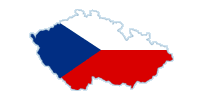Czech Republic Guide 
The Czech Republic consists of three historical countries – Bohemia, Moravia and Czech Silesia. The Czech Republic is famous for its historical cities such as Prague and Český Krumlov, castles and chateaux, beautiful nature and beer. Charles University in Prague is the oldest university in Central Europe. The key sectors of the Czech economy are mechanical engineering, the automotive industry, IT and healthcare.
Prague - The capital and largest city of the Czech Republic with more than 1.39 million inhabitants covers an area of about 500 km². It is located in the center of Bohemia on the banks of the Vltava River. It is an important historical, cultural and economic center. Prague is famous for its UNESCO-protected historic center with monuments such as Prague Castle, Charles Bridge and Old Town Square.
Český Krumlov - A picturesque historic city in southern Bohemia is famous for its well-preserved medieval center and monumental castle, the second largest in the Czech Republic. It is located in a meander of the Vltava River and has been on the UNESCO World Heritage List since 1992. Important noble families such as the Rožmberks and Schwarzenbergs lived here.
Brno - The second largest city of the Czech Republic and the former capital of historical Moravia is located in southern Moravia in a picturesque basin at the confluence of the Svratka and Svitava rivers. With more than 380,000 inhabitants, Brno is one of the country's major university, scientific and industrial centers, and is also famous for its diverse architecture, led by the functionalist Villa Tugendhat (UNESCO).

A landlocked country located in Central Europe, it borders Austria to the south, Germany to the west, Poland to the north and Slovakia to the east. It covers an area of 78,870 km². It is home to just under 11 million people. The population density is about 133 people per km². The capital and largest city is Prague, other important cities include Brno, Ostrava, Pilsen, Liberec and Olomouc. The Czech Republic is nicknamed the "heart of Europe" because it is the geographical centre of the old continent.

The Czech Republic is located in a temperate climate zone with four seasons. The highest point of the republic is Mount Sněžka (1,602 m above sea level), the lowest point is the level of the Elbe near Hřensko (115 m above sea level). The surface of the Czech Republic consists mainly of hills, central mountains, rivers and lowlands - the main rivers are the Elbe, Vltava, Morava, Dyje and Oder. The mountain ranges that form the natural borders of the state play a significant role.

The territory of today's Czech Republic was settled as early as the Paleolithic period. The historical Czech state was founded as a principality in the 9th century, later elevated to a kingdom. The Czech state belonged to the Holy Roman Empire and later (from 1526) formed part of the Austro-Hungarian Empire. After the First World War, Czechoslovakia was founded in 1918. During the 20th century, the region went through Nazi occupation, a communist regime and the Velvet Revolution in 1989. The independent Czech Republic was founded on January 1, 1993 after the division of Czechoslovakia.
The economy of the Czech Republic is developed and heavily industrial. Industry makes up approximately 38% of the Czech economy and employs a similar share of the economically active population. Key sectors include mechanical engineering, automotive, chemical, metallurgical, food, glass, consumer and construction industries. The IT sector, biotechnology, healthcare and services also play an important role. Agriculture employs a smaller share of the population. Since the end of the 20th century, the share of people employed in services has been increasing and the popularity of Czech destinations among foreign tourists is growing. Tourists most often head to the capital city of Prague, the historic town of Český Krumlov in southern Bohemia, or to ancient Kutná Hora, where silver was mined in the Middle Ages. For example, in 2024, over 8 million tourists came to Prague, of which over 80% were foreign visitors.

The Czech Republic holds the world lead in the amount of beer drunk per capita. You can also find over 500 different breweries here. Traditional Czech dishes include vepró knedlo zelo, svíčková, goulash, fruit dumplings or fried cheese.
